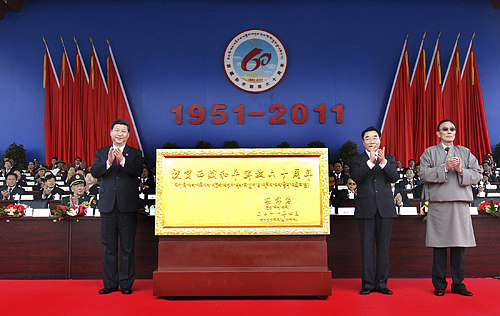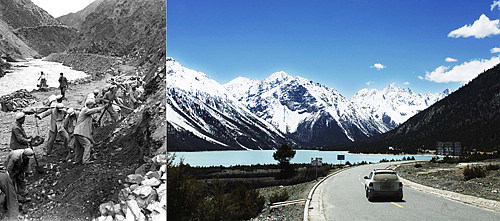|
 |
|
ANNIVERSARY GIFT: Chinese Vice President Xi Jinping (left) presents Tibet's local government with a gold-plated plaque bearing an inscription by President Hu Jintao, congratulating the region on the 60th anniversary of its peaceful liberation, at a gathering in Lhasa, capital of Tibet Autonomous Region, on July 19 (LAN HONGGUANG) |
The 14th Dalai Lama originally agreed with and supported the signing of the 17-Article Agreement, but later he broke his promise and fled abroad to engage in separatist activities. What's your comment?
The 14th Dalai Lama was only 16 years old and had just assumed power when the 17-Article Agreement was signed. Acknowledging the situation and influenced by patriotic upper-class Tibetans, such as Ngapoi Ngawang Jigme and the 10th Panchen Lama, he decided to assign delegates to negotiate with the Central Government in Beijing.
After the agreement was signed, the 14th Dalai Lama openly declared that he accepted the 17-Article Agreement on behalf of the local government of Tibet. In a telegram to Chairman Mao Zedong, he said, "The local government of Tibet as well as the ecclesiastical and secular people unanimously support this agreement, and, under the leadership of Chairman Mao and the Central People's Government, will actively assist the PLA troops entering Tibet to consolidate national defense, ousting imperialist influences from Tibet and safeguarding the unification of the territory and the sovereignty of the motherland." The decision turned out to be one of the 14th Dalai Lama's correct decisions.
The Central Government highly recognized the role of the 14th Dalai Lama in Tibet's peaceful liberation. In 1954, Chairman Mao and Premier Zhou Enlai met with him several times when he attended the First Session of the First National People's Congress (NPC), China's top legislative body. At the session, he was elected vice chairman of the Standing Committee of the NPC. The position was preserved for him until 1964 after he fled abroad in 1959. Initially the Central Government said that the Dalai Lama's flight was a forced escape, given his personal reputation.
Unfortunately, it was the 14th Dalai Lama himself who tarnished his own reputation. In 1959, after a failed armed rebellion staged by a few upper-class Tibetans, he fled abroad, tearing up the 17-Article Agreement en route. More than 50 years have passed since then.
 |
|
PAST AND PRESENT: After the peaceful liberation of Tibet in 1951, great efforts have been made to make Tibet accessible by roads. The Sichuan-Tibet Highway pictured here is one of the grand projects (XINHUA) |
What measures have the Central Government taken to boost Tibet's development?
Tibet is the only provincial-level autonomous region for which the Central Government has held five development-centered work conferences since the implementation of the reform and opening-up policy in the late 1970s.
First of all, Tibet is located at a high-altitude, with extremely harsh natural conditions. This presents a particular barrier to Tibet's economic and social development. Second, for long periods in history, Tibet was ruled under a theocratic feudal serfdom, which impeded its development. So following its peaceful liberation, its level of development was far behind inland areas of China. Third, the Dalai clique, under the support of anti-China Western forces, has always conspired to split Tibet from China. Fourth, Tibet in southwest China shares long borders with South Asian countries. The stability and development of Tibet are important as it allows China to maintain friendly, cooperative and mutually beneficial relations with those countries.
Both the Central Government and ordinary people are fully aware of the situation. So they are determined to stick to the policy of mobilizing national resources to support the development of Tibet.
For example, the third work conference on Tibet in 1994 launched a partnership assistance program, which assigned Central Government departments in 15 provinces and municipalities to build 62 key aid projects in Tibet. In 2001, the fourth work conference on Tibet decided to extend the duration of the partnership assistance program from 10 years to 20 years, and widened the scope of the program, involving 59 Central Government departments. Other provinces and autonomous regions have also contributed to Tibet's development. During the 11th Five-Year Plan (2006-10), aid to Tibet amounted to 7.6 billion yuan ($1.18 billion). The fifth work conference on Tibet in 2010 required all aid-providing provinces and municipalities to allocate no less than one thousandth of their disposable annual revenue to support the development of Tibet. This measure has been fully implemented by all the regions concerned.
The 3 million Tibetans who receive aid from other parts of China have contributed to national unity and development.
People of different ethnic groups living in Tibet from ancient times have developed a unique and valuable culture. They are also guardians of a vast 1.2-million-square-km territory in the southwestern part of China. In the 60 years since the peaceful liberation of the region, Tibet has remained stable and experienced steady economic growth. Today the region is an important defense and ecological shield for the country, a reserve of strategic resources, and producer of highland agricultural crops. It is also a world-renowned tourist destination and one of China's ethnic culture protection zones.
| 